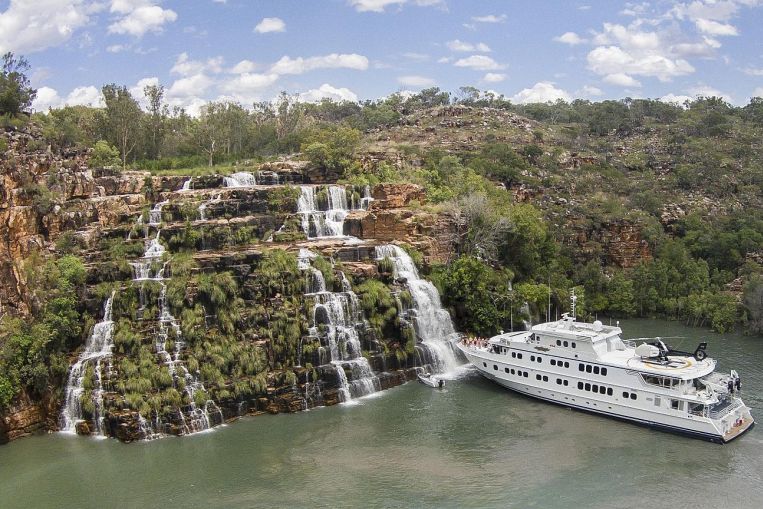Around 30 million people worldwide were expected to cruise last year, and the industry was experiencing extraordinary growth, year on year.
Then Covid-19 slammed the brakes on the lucrative market.
But, despite the negative images of the cruise industry's pandemic woes in the media – such as those of passengers leaving ships on stretchers – some loyal travellers insist they wish to holiday on boats.
Much to the delight of its customers, Norwegian cruise company Hurtigruten made history on June 16. The MS Finnmarken, carrying 200 Norwegian and Danish passengers, departed from Bergen, becoming the first ocean cruise to set sail since the pandemic shut down the industry.
The 127-year-old company runs expedition cruises and a ferry service along the Norwegian coast, and its vital cargo transport to remote Norwegian towns continued during the shutdown.
Chief executive officer Daniel Skjeldam was on board the smartly refurbished Finnmarken and, via a live video feed from the spectacular Geiranger Fjord, he explained how much it meant to his company and also locals to see Hurtigruten out at sea again.
"When we left Bergen last night, it was a truly emotional moment," he said.
"We had locals in small boats waving to us and one of them even lifted a trumpet to give us a small serenade as we were leaving."
The company has adopted many new protocols to keep passengers and crew safe. For instance, it is running its ships at around 50 per cent passenger capacity to allow for proper social distancing.
Boarding is subject to enhanced health checks, with high-tech temperature screening of passengers and crew before and during the cruise.
Buffets are gone and passengers use their phones and QR codes to consult menus.
A full-time health and safety officer on board ensures compliance with the new regimen.
In accordance with Norwegian health authority guidelines, face masks are not mandatory, although on-board sanitisation has been increased in frequency and intensity both before and during each journey.
All crew members are trained to World Health Organisation standards for Covid-19.
Hurtigruten is now operating four ships on its Norwegian coastal route. To comply with international travel restrictions, passengers from different countries and regions will not mix.
Since June 26, it has commenced operating its newest ship, the hybrid-powered MS Fridtjof Nansen from Hamburg, exclusively for German residents.
Guests on these expedition cruises are permitted to kayak and take small boat excursions, although shore excursions for international visitors on the Norwegian coast will not be allowed initially.
Next year, the company will offer departures for British residents on a ship home-ported in Dover, England.
SMALL SHIPS LEAD THE WAY
Similar to small-ship ocean cruising, some river cruise companies are also resuming operations, especially in countries where the Covid-19 infection rates are being controlled.
In Germany, Nicko Cruises was one of the first to sail again, taking to the Rhine River on June 1.
A-Rosa Cruises set sail on June 17 in Portugal, while voyages in France were planned for yesterday.
In North America, plagued by increasing Covid-19 cases, cruises will not be setting off any time soon.
The Centers for Disease Control and Prevention in the United States has imposed "no-sail" orders on ships carrying more than 250 passengers until July 24, although the Cruise Lines International Association reports that its members have voluntarily suspended US operations until at least Sept 15.
The no-sail order does not specifically exclude smaller ships from operating. On June 20, American Cruise Lines had intended to launch the first North American cruise since the pandemic shutdown on the Oregon and Snake Rivers. But, days before, changes in Oregon state's regulations banned all overnight cruises, regardless of passenger capacity.
Across the Asian region, cruising is showing the first signs of recovery.
Royal Caribbean Cruises will sail from Beijing to Japan on Aug 2, while Aqua Expeditions will operate a Mekong River cruise from Phnom Penh to Ho Chi Minh on Aug 7.
The Genting Dream is scheduled to sail from Singapore to Port Dickson in Malaysia, for a two-night voyage from Sept 2, and to Bintan two days later.
In Australia, cruise ships carrying more than 100 passengers are banned until Sept 17. Meanwhile, smaller boutique ships are taking to the water.
Some Australian states have closed their internal borders to other states and, despite the very low rates of Covid-19 infections, it can be difficult for Australians to join these domestic cruises.
On July 4, the 36-passenger True North resumed expedition ocean cruising in Western Australia's remote Kimberley region between the northern towns of Broome and Wyndham.
Despite the state border closure, the cruise was fully booked with Western Australians jumping at the chance to travel again.
RE-EVALUATING CRUISING
Aside from the improved hygiene protocols, the Covid-19 pause may change the industry in other ways.
Cruising has been the target of some high-profile criticism throughout the pandemic, giving passengers and operators food for thought about the future.
Images of large, stranded cruise ships are hard to forget and several Read More – Source
Around 30 million people worldwide were expected to cruise last year, and the industry was experiencing extraordinary growth, year on year.
Then Covid-19 slammed the brakes on the lucrative market.
But, despite the negative images of the cruise industry's pandemic woes in the media – such as those of passengers leaving ships on stretchers – some loyal travellers insist they wish to holiday on boats.
Much to the delight of its customers, Norwegian cruise company Hurtigruten made history on June 16. The MS Finnmarken, carrying 200 Norwegian and Danish passengers, departed from Bergen, becoming the first ocean cruise to set sail since the pandemic shut down the industry.
The 127-year-old company runs expedition cruises and a ferry service along the Norwegian coast, and its vital cargo transport to remote Norwegian towns continued during the shutdown.
Chief executive officer Daniel Skjeldam was on board the smartly refurbished Finnmarken and, via a live video feed from the spectacular Geiranger Fjord, he explained how much it meant to his company and also locals to see Hurtigruten out at sea again.
"When we left Bergen last night, it was a truly emotional moment," he said.
"We had locals in small boats waving to us and one of them even lifted a trumpet to give us a small serenade as we were leaving."
The company has adopted many new protocols to keep passengers and crew safe. For instance, it is running its ships at around 50 per cent passenger capacity to allow for proper social distancing.
Boarding is subject to enhanced health checks, with high-tech temperature screening of passengers and crew before and during the cruise.
Buffets are gone and passengers use their phones and QR codes to consult menus.
A full-time health and safety officer on board ensures compliance with the new regimen.
In accordance with Norwegian health authority guidelines, face masks are not mandatory, although on-board sanitisation has been increased in frequency and intensity both before and during each journey.
All crew members are trained to World Health Organisation standards for Covid-19.
Hurtigruten is now operating four ships on its Norwegian coastal route. To comply with international travel restrictions, passengers from different countries and regions will not mix.
Since June 26, it has commenced operating its newest ship, the hybrid-powered MS Fridtjof Nansen from Hamburg, exclusively for German residents.
Guests on these expedition cruises are permitted to kayak and take small boat excursions, although shore excursions for international visitors on the Norwegian coast will not be allowed initially.
Next year, the company will offer departures for British residents on a ship home-ported in Dover, England.
SMALL SHIPS LEAD THE WAY
Similar to small-ship ocean cruising, some river cruise companies are also resuming operations, especially in countries where the Covid-19 infection rates are being controlled.
In Germany, Nicko Cruises was one of the first to sail again, taking to the Rhine River on June 1.
A-Rosa Cruises set sail on June 17 in Portugal, while voyages in France were planned for yesterday.
In North America, plagued by increasing Covid-19 cases, cruises will not be setting off any time soon.
The Centers for Disease Control and Prevention in the United States has imposed "no-sail" orders on ships carrying more than 250 passengers until July 24, although the Cruise Lines International Association reports that its members have voluntarily suspended US operations until at least Sept 15.
The no-sail order does not specifically exclude smaller ships from operating. On June 20, American Cruise Lines had intended to launch the first North American cruise since the pandemic shutdown on the Oregon and Snake Rivers. But, days before, changes in Oregon state's regulations banned all overnight cruises, regardless of passenger capacity.
Across the Asian region, cruising is showing the first signs of recovery.
Royal Caribbean Cruises will sail from Beijing to Japan on Aug 2, while Aqua Expeditions will operate a Mekong River cruise from Phnom Penh to Ho Chi Minh on Aug 7.
The Genting Dream is scheduled to sail from Singapore to Port Dickson in Malaysia, for a two-night voyage from Sept 2, and to Bintan two days later.
In Australia, cruise ships carrying more than 100 passengers are banned until Sept 17. Meanwhile, smaller boutique ships are taking to the water.
Some Australian states have closed their internal borders to other states and, despite the very low rates of Covid-19 infections, it can be difficult for Australians to join these domestic cruises.
On July 4, the 36-passenger True North resumed expedition ocean cruising in Western Australia's remote Kimberley region between the northern towns of Broome and Wyndham.
Despite the state border closure, the cruise was fully booked with Western Australians jumping at the chance to travel again.
RE-EVALUATING CRUISING
Aside from the improved hygiene protocols, the Covid-19 pause may change the industry in other ways.
Cruising has been the target of some high-profile criticism throughout the pandemic, giving passengers and operators food for thought about the future.
Images of large, stranded cruise ships are hard to forget and several Read More – Source












